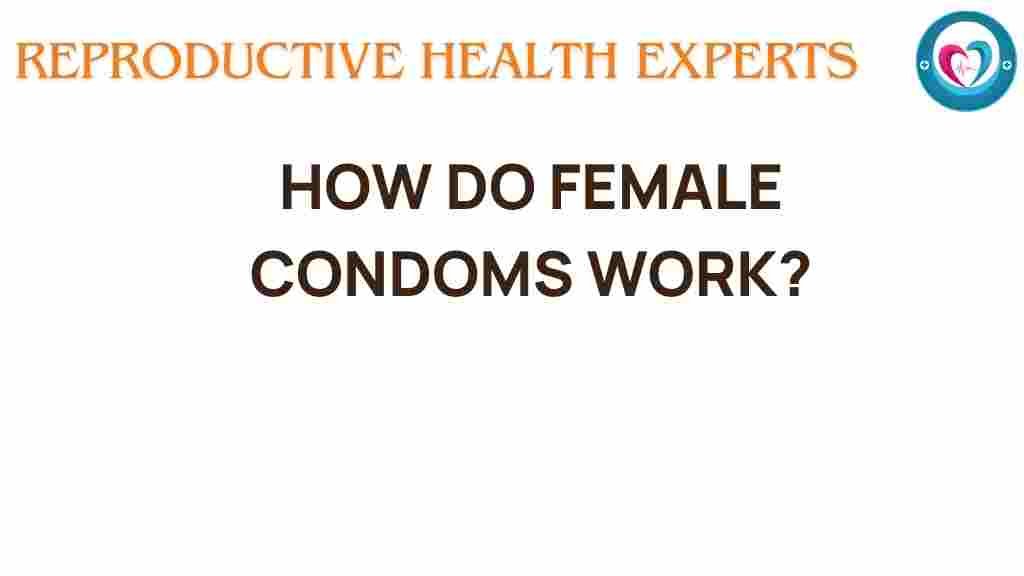Unveiling the Mystery: How Do Female Condoms Work?
In the realm of contraception and sexual health, female condoms often remain an overlooked option despite their numerous benefits. Understanding how female condoms work is essential for anyone looking to make informed reproductive choices. This article delves into the mechanics of female condoms, their effectiveness in contraception, their role in STI prevention, and how they contribute to women’s health and sexual wellness.
What Are Female Condoms?
Female condoms are a type of barrier method designed to prevent pregnancy and reduce the risk of sexually transmitted infections (STIs). Unlike male condoms, which are worn on the penis, female condoms are inserted into the vagina before sexual intercourse. They provide a flexible and effective means of contraception and are an empowering choice for women seeking control over their sexual health.
How Do Female Condoms Work?
The primary function of female condoms is to create a barrier that prevents sperm from entering the uterus, thereby reducing the likelihood of pregnancy. Here’s a step-by-step look at how female condoms work:
- Preparation: Before using a female condom, ensure that it is within the expiration date and the packaging is intact. Check for any visible damage.
- Insertion: Carefully open the package, avoiding sharp objects that could tear the condom. Squeeze the inner ring of the condom and insert it into the vagina. Push it up as far as it will go, ensuring the outer ring remains outside the vagina.
- During Intercourse: The male partner should guide his penis into the condom. The design of the female condom allows for movement, ensuring it stays in place while providing protection.
- After Use: Once intercourse is complete, twist the outer ring to seal the condom and carefully pull it out. Dispose of it in the trash; do not flush it down the toilet.
Effectiveness of Female Condoms
When used correctly, female condoms can be up to 95% effective in preventing pregnancy. However, typical use may lower this effectiveness to around 79%. To maximize effectiveness, it is crucial to follow the insertion and usage instructions accurately. Here are some key points regarding their effectiveness:
- They act as a barrier method, preventing sperm from reaching the egg.
- They also help reduce the risk of STIs, including HIV.
- Female condoms are made from nitrile or latex, which are effective in preventing pregnancy.
Benefits of Using Female Condoms
Female condoms offer several advantages that contribute to sexual wellness and reproductive choices:
- Empowerment: Female condoms allow women to take control of their contraception and sexual health.
- STI Prevention: They provide a protective barrier against STIs, making them a safe option for sexually active individuals.
- Compatibility: Female condoms can be used with both oil-based and water-based lubricants.
- No Prescription Required: They are available over-the-counter, making them accessible to all.
Challenges and Troubleshooting Tips
While female condoms are an excellent option for many, they can pose challenges if not used correctly. Here are some common issues and troubleshooting tips:
Common Issues
- Slippage: Sometimes, the condom may slip out during intercourse.
- Discomfort: Some users may find the condom uncomfortable.
- Noise: The material may create noise during use, which can be distracting.
Troubleshooting Tips
- To Prevent Slippage: Ensure the condom is inserted correctly and that the outer ring is outside the vagina.
- For Discomfort: Experiment with different positions or use lubrication to enhance comfort.
- If Noise Occurs: Try using more lubrication to reduce friction, which may help minimize sound.
Female Condoms and Women’s Health
Using female condoms is a proactive step towards maintaining women’s health. By allowing women to participate actively in contraception, female condoms promote:
- Informed Choices: Women can choose a method that best fits their lifestyle and health needs.
- Regular STI Screening: Using barriers like female condoms encourages routine sexual health check-ups.
- Better Communication: They foster open discussions between partners about contraception and safe sex practices.
Conclusion
Female condoms represent a valuable tool in the landscape of contraception and sexual health. They provide an effective means of preventing pregnancy and STIs, empowering women to make informed reproductive choices. By understanding how female condoms work, their benefits, and how to troubleshoot common issues, individuals can enhance their sexual wellness and promote safer sex practices.
For more information on different contraceptive methods, including female condoms, visit Planned Parenthood. Always consult with a healthcare provider for personalized advice on sexual health and contraception.
By embracing options like female condoms, individuals take crucial steps toward responsible sexual health and wellness, contributing to a safer and more informed society.
This article is in the category Prevention and created by ReproductiveHealthExperts Team

4 thoughts on “Unveiling the Mystery: How Do Female Condoms Work?”